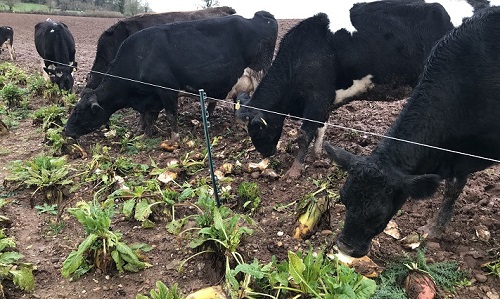Published
23 .Apr.2020Fodder beet proves a success in Devon
Bangor fodder beet has been a popular winter feed for College dairy herd
In East Devon at the Bicton College herd, fodder beet has been grown and fed to 55 outwintered cross-bred milking cows and 150 dry cows and heifers, for the first time this year.
Two hectares of Bangor fodder beet was drilled in April 2019, into a free-draining, sandy grass field that had been sprayed off, ploughed, limed, cultivated twice and power harrowed, with 105kg/ha of nitrogen applied to the seed bed. Three herbicide sprays killed off any competition from weeds in the first eight weeks.
“We have grown forage rape and stubble turnips separately in the past, but the fodder beet fills the winter gap in grass growth and provides much higher energy at 12 MJ ME,” says Farms Manager James Coumbe.
“We started to graze it in late September and the cows love it. It is really palatable and digestible, and it has really helped push the litres up and given the cows a longer tail to their lactations. Milk quality now sits at 4.96% fat and 4.12% protein.”

Bicton College dairy cows tuck into a fresh allocation of fodder beet
The Bicton herd is run as a low input/low output system with the cows yielding 5,000 litres on average and only being housed for three weeks in the year.
“We chose the site to grow the fodder beet really carefully to prevent soil run-off and offer it to the cows behind an electric fence. The cows can also access grass where they can graze or lie down.
“It is important to introduce the cows to the beet slowly to prevent acidosis, increasing by 1kg a day up to a maximum of 7-8kg/day. The cows receive maize and grass silage in the yard at milking and a small amount of cake in the parlour.”
John Harris of Oliver Seeds offers agronomic advice to Mr. Coumbe on his fodder beet and says that in future years he would also advise the use of fungicide, a foliar feed including boron and the addition of sodium in the crop nutrition plan. Flea beetles and aphids can also be problem in some crops.
“Fodder beet is an expensive crop to grow,” admits Mr. Coumbe. “But high yields of up to 18t dry matter/hectare brings the cost per tonne of dry matter right down. As a first time grower I am really impressed with it.”
This article was first published in Cow Management in March 2020
